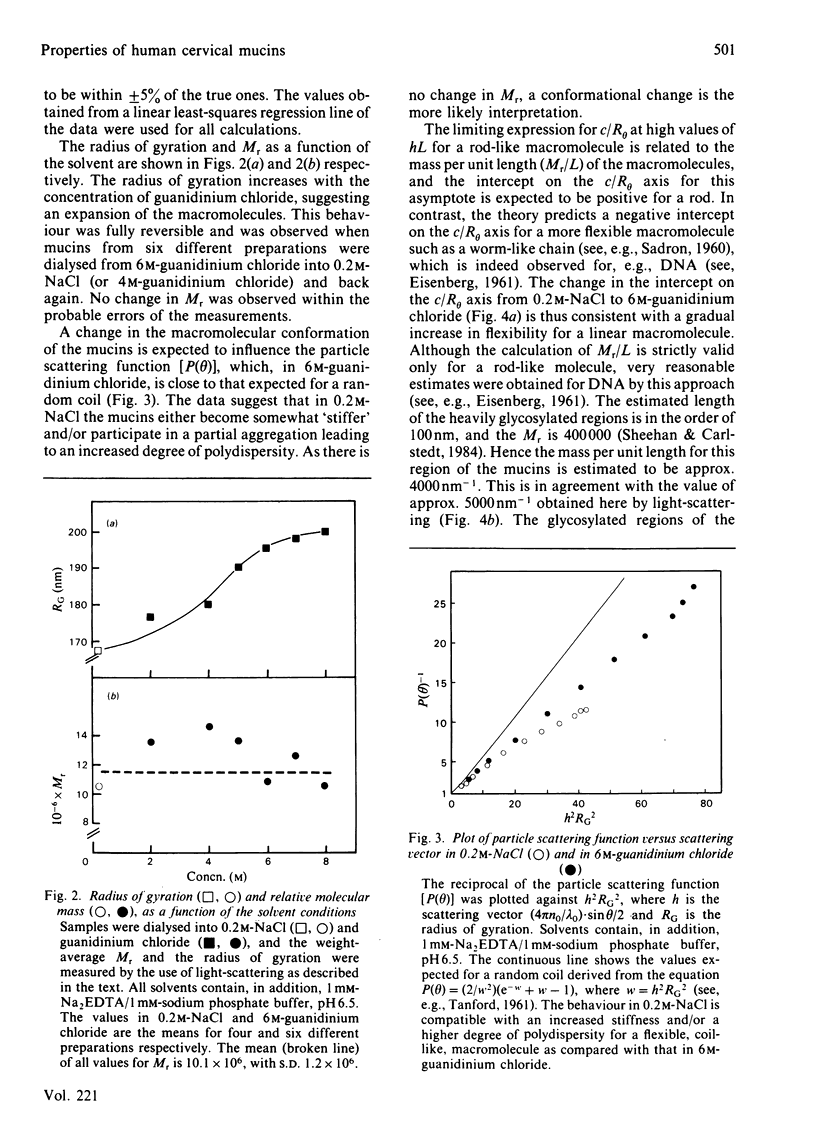Abstract
The macromolecular properties of cervical-mucus glycoproteins (mucins) were studied as a function of the concentration of guanidinium chloride with conventional light-scattering, photon-correlation spectroscopy and sedimentation-velocity centrifugation. No evidence for an association of the mucins in 0.2M-NaCl as compared with 6M-guanidinium chloride was found at mucin concentrations below approx. 0.5 mg/ml. However, an increase in the frictional coefficient and in the radius of gyration occurred with increasing concentrations of guanidinium chloride, in particular between 4 M and 6 M, suggesting an expansion of the individual macromolecule. The change in the particle-scattering function is consistent with a transition from a 'stiff' random coil in 0.2 M-NaCl into a more flexible one in 6 M-guanidinium chloride. We suggest that the mucins contain regions of 'ordered' structure which can undergo a reversible 'unfolding' analogous to the behaviour of a conventional globular protein exposed to a denaturing solvent. Such regions might carry sites for specific interactions between mucins and/or be decisive for their conformation and macromolecular properties in physiological solvents.
Full text
PDF





Selected References
These references are in PubMed. This may not be the complete list of references from this article.
- CASASSA E. F., EISENBERG H. THERMODYNAMIC ANALYSIS OF MULTICOMPONENT SOLUTIONS. Adv Protein Chem. 1964;19:287–395. doi: 10.1016/s0065-3233(08)60191-6. [DOI] [PubMed] [Google Scholar]
- Carlstedt I., Lindgren H., Sheehan J. K. The macromolecular structure of human cervical-mucus glycoproteins. Studies on fragments obtained after reduction of disulphide bridges and after subsequent trypsin digestion. Biochem J. 1983 Aug 1;213(2):427–435. doi: 10.1042/bj2130427. [DOI] [PMC free article] [PubMed] [Google Scholar]
- Carlstedt I., Lindgren H., Sheehan J. K., Ulmsten U., Wingerup L. Isolation and characterization of human cervical-mucus glycoproteins. Biochem J. 1983 Apr 1;211(1):13–22. doi: 10.1042/bj2110013. [DOI] [PMC free article] [PubMed] [Google Scholar]
- Creeth J. M., Knight C. G. The macromolecular properties of blood-group substances. Sedimentation-velocity and viscosity measurements. Biochem J. 1967 Dec;105(3):1135–1145. doi: 10.1042/bj1051135. [DOI] [PMC free article] [PubMed] [Google Scholar]
- Harding S. E., Creeth J. M. Polyelectrolyte behaviour in mucus glycoproteins. Biochim Biophys Acta. 1983 Jul 28;746(1-2):114–119. doi: 10.1016/0167-4838(83)90017-1. [DOI] [PubMed] [Google Scholar]
- Harding S. E., Rowe A. J., Creeth J. M. Further evidence for a flexible and highly expanded spheroidal model for mucus glycoproteins in solution. Biochem J. 1983 Mar 1;209(3):893–896. doi: 10.1042/bj2090893. [DOI] [PMC free article] [PubMed] [Google Scholar]
- Jourdian G. W., Dean L., Roseman S. The sialic acids. XI. A periodate-resorcinol method for the quantitative estimation of free sialic acids and their glycosides. J Biol Chem. 1971 Jan 25;246(2):430–435. [PubMed] [Google Scholar]
- Sheehan J. K., Carlstedt I. Hydrodynamic properties of human cervical-mucus glycoproteins in 6M-guanidinium chloride. Biochem J. 1984 Jan 1;217(1):93–101. doi: 10.1042/bj2170093. [DOI] [PMC free article] [PubMed] [Google Scholar]
- Snary D., Allen A., Pain R. H. Conformational changes in gastric mucoproteins induced by caesium chloride and guanidinium chloride. Biochem J. 1974 Sep;141(3):641–646. doi: 10.1042/bj1410641. [DOI] [PMC free article] [PubMed] [Google Scholar]
- Wolf D. P., Blasco L., Khan M. A., Litt M. Human cervical mucus. IV. Viscoelasticity and sperm penetrability during the ovulatory menstrual cycle. Fertil Steril. 1978 Aug;30(2):163–169. doi: 10.1016/s0015-0282(16)43454-0. [DOI] [PubMed] [Google Scholar]


